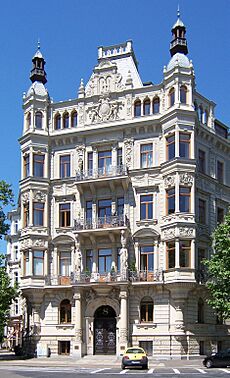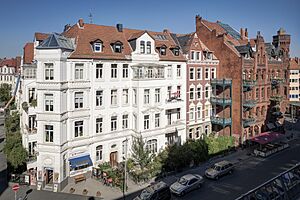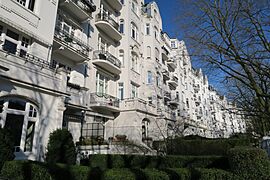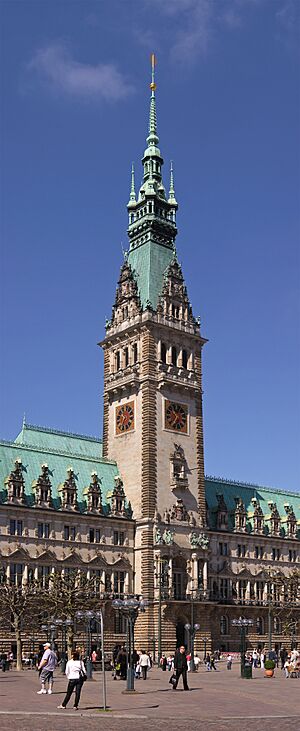Gründerzeit facts for kids

The Gründerzeit (pronounced GROWN-der-tsite) was a special time in Germany and Austria during the 1800s. It means "founders' period" and was a time of fast economic growth and many new businesses. This exciting period happened just before a big stock market crash in 1873.
Contents
A Time of Economic Boom

The "age of the founders" was a short but powerful time, lasting only about six years, from 1867 to 1873. During this period, the German Empire saw a huge economic boost. Hundreds of new companies, banks, and railways were started. It was a time when many people became very rich, and the country grew quickly.
Amazing Design and Architecture

Because of all the new factories and jobs, more and more people moved to cities. This meant there was a big need for new homes. Whole neighborhoods were built in what is called the Founding Epoch Architecture style. Even today, if you visit cities in Central Europe, you'll see many buildings from this time.
These buildings usually had four to six floors. They often had very fancy fronts with lots of decorations. These decorations used styles from the past, like Gothic, Renaissance, and Baroque. Rich citizens built grand palaces, while many new apartment buildings were also built for the growing number of workers.
This period was also important for using new technology in buildings. A big step was the invention of the Bessemer process, which made it easier to produce steel. This meant buildings could have steel parts, like the amazing Crystal Palace built in 1851. It was made of steel and glass, which was very new and inspired many buildings that came after it.
Many "Gründerzeit districts" were built across Germany, Austria, and even Hungary.
- Examples of Gründerzeit districts
The Gründerzeit in Austria
In Austria, the Gründerzeit started a bit earlier, around 1840. This was when factories began to grow in Vienna and other areas like Bohemia and Moravia. Vienna, the capital city, grew very fast. It became one of the largest cities in the world as people moved in from all over Austria.
Where the old city walls once stood, a grand ring road was built. Along this road, impressive public buildings were constructed, such as the Opera House, the Town Hall, and the Parliament. Wealthy citizens also built beautiful homes and monuments. Other cities like Graz also saw new buildings, but on a smaller scale.
The Gründerzeit in Germany
For many Germans, this era is strongly connected to Kaiser Wilhelm I and Chancellor Bismarck. It was like a "Golden Age" for Germany. The country recovered from past wars and became a strong competitor in science, technology, industry, and trade. The middle class in Germany saw their lives improve greatly, buying modern furniture and household items.
During this time, many books and papers were published in German-speaking areas. Most of these were academic papers or guides on practical topics. This helped new knowledge spread quickly to many people.
However, there were also challenges. As farming became more efficient with new machines, many farm workers lost their jobs. This led to more people moving to cities or even leaving the country, often going to America.
In the fast-growing industrial cities, new homes for workers were built. These homes were often small, dark, and crowded. Doctors at the time even said they were unhealthy. These conditions were blamed for the spread of diseases like tuberculosis.
Despite these challenges, the lives of working-class people also improved in some ways. Laws were introduced by Bismarck in 1883–1884 to provide social security, like workers' health insurance and accident insurance. This was a big step towards a system of social care that is still important in Germany today.






